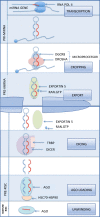The role of microRNAs in human embryo implantation: a review
- PMID: 30315515
- PMCID: PMC6420523
- DOI: 10.1007/s10815-018-1326-y
The role of microRNAs in human embryo implantation: a review
Abstract
MicroRNAs (miRNAs) are emerging as important in human embryo implantation, and we present here a review of the literature from a clinical perspective. Implantation involves complex interactions between the blastocyst and endometrium. miRNAs have been shown to be differentially expressed in implanted compared with non-implanted blastocysts and euploid compared with aneuploid blastocysts. Further, miRNAs are differentially expressed in proliferative compared with decidualized endometrium, and in receptive compared with pre-receptive endometrium. miRNAs are also differentially expressed in endometrium of women who failed implantation, and in endometrium of women with recurrent implantation failure. Due to the complexity of miRNA signaling, studies have suffered from inconsistency in reproducibility of results. However, miRNAs show potential as biomarkers in the pursuit of more reliable prediction of embryo implantation.
Keywords: Endometrium; Human embryo; Implantation; MicroRNA; Pregnancy; Recurrent implantation failure.
Conflict of interest statement
The authors declare that they have no conflict of interest
Figures




References
-
- Liu W, Niu Z, Li Q, Pang RTK, Chiu PCN, Yeung WSB. MicroRNA and embryo implantation. American Journal of Reproductive Immunology. 2016. - PubMed
-
- Salamonsen LA, Evans J, Nguyen HPT, Edgell TA. The microenvironment of human implantation: Determinant of reproductive success. American Journal of Reproductive Immunology. 2016. - PubMed
Publication types
MeSH terms
Substances
LinkOut - more resources
Full Text Sources

